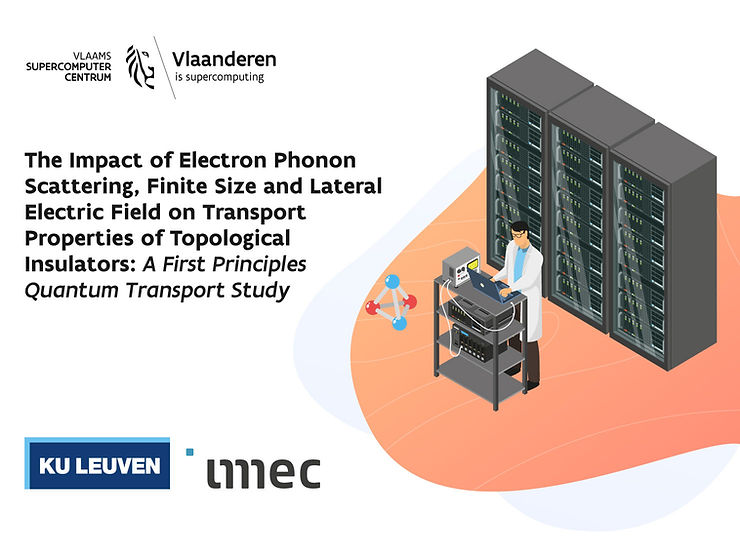The Impact of Electron Phonon Scattering, Finite Size and Lateral Electric Field on Transport Properties of Topological Insulators: A First Principles Quantum Transport Study
By: Elaheh Akhoundi 1,2, Michel Houssa 1,2 and Aryan Afzalian 1,*
1 IMEC, B-3001 Leuven, Belgium; elaheh.akhoundi@imec.be (E.A.); michel.houssa@imec.be (M.H.)
2 Department of Physics, KU Leuven, B-3001 Leuven, Belgium
* Correspondence: aryan.afzalian@imec.be

Two-dimensional topological insulators (2D TIs) are characterized by having unique edge properties. They are insulators in their bulk yet have gapless counter-propagating channels at the edges. These metallic edge states are spin-polarized and protected by the topology of the bulk band structure as well as the preserved time-reversal symmetry. In other words, electrons are restricted to move in opposite directions with opposite spins in spatially separated highways, which can suppress collisions and scattering significantly. This coupled with the spin texture of the edge states makes TIs promising candidates to be used in various applications such as logic, memory, and quantum computing.
Here, we used density functional theory to study the electronic and structural properties of TIs in equilibrium. Additionally, we employed our atomistic quantum transport simulator ATOMOS within the non-equilibrium Green’s function formalism (NEGF) to investigate the transport properties of TI nanoribbons driven out of equilibrium. NEGF provides a sound platform to perform quantum simulations in various nanoscale structures. It allowsfor including the coupling to the contacts and electron-phonon scattering processes through self-energy matrices.
(a) Atomic structure of stanene zigzag ribbon. The arrows demonstrate the helical edge channels (b) spin resolved electronic band structure of 6 nm wide zigzag stanene ribbon. The contribution of edge atoms to the energy states is demonstrated. For electron backscattering to occur, the spin needs to be reversed. (c) The calculated current for three different materials as a function of the deformation potential (deformation potential is an effective constant proportional to the strength of e-ph scattering). (d) Upon the application of a lateral electric field, a gap opens in the band structure of a 2.5 nm wide statene zigzag ribbon (the highlighted energy gap). This can be used in the design of TI based transistors.
We used our massively parallel solver (using hybrid mpi/openmp) in conjunction with state-of-the-art acceleration techniques and the high-performance computing infrastructure provided by the VSC to cope with the computational burden.
As an application, dissipation transistors based on TIs have been proposed. Certain TIs can undergo a topological phase transition (and a band gap opening) by applying an electric field. Here we observed that a lateral electric field can be used to open a band gap in stanene and possibly switch off the transistor. Using DFT-NEGF, we studied the operation of such a transistor and observed that the critical field needs to be significantly reduced by selecting the right TI or using other approaches, such as introducing a built-in electric field.
We continue expanding our work on this topic by further looking into various aspects of TI physics and their applications.
The full publication on this article can be found in MDPI








